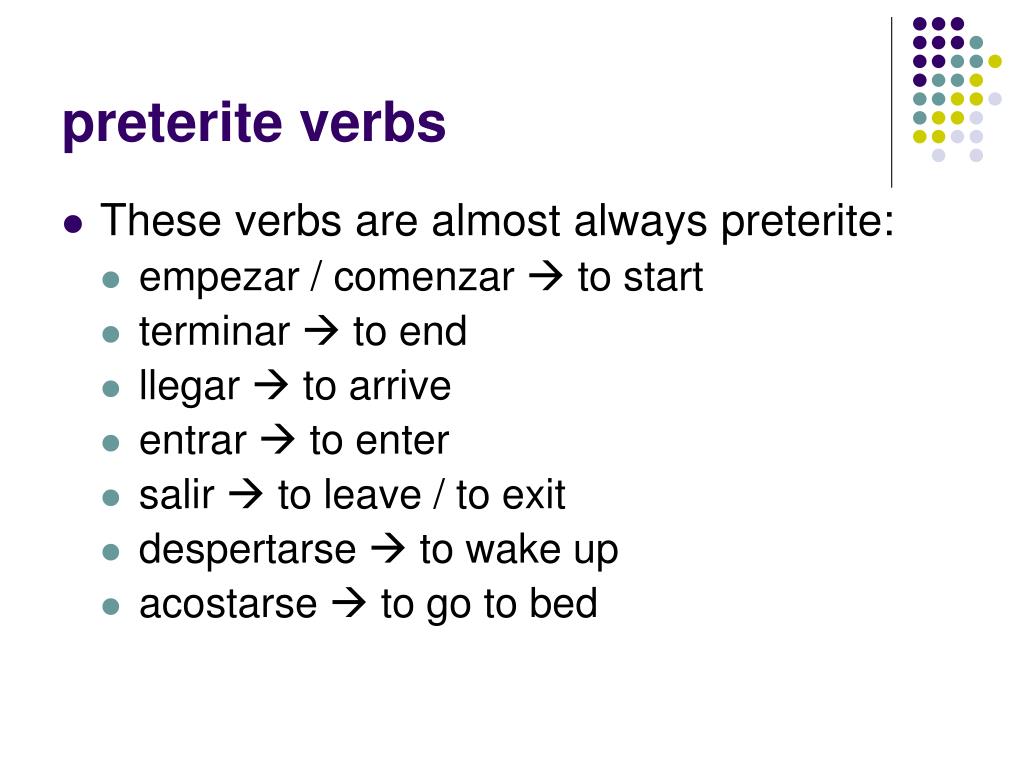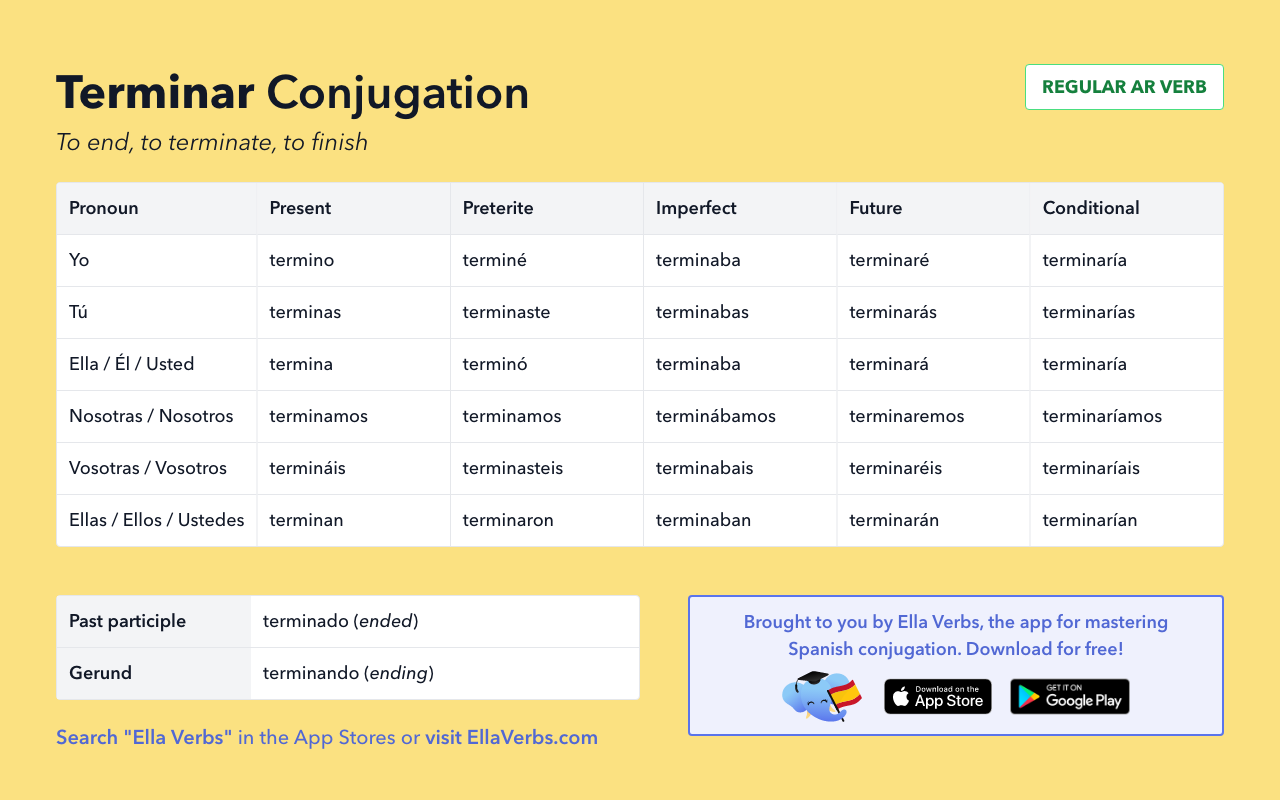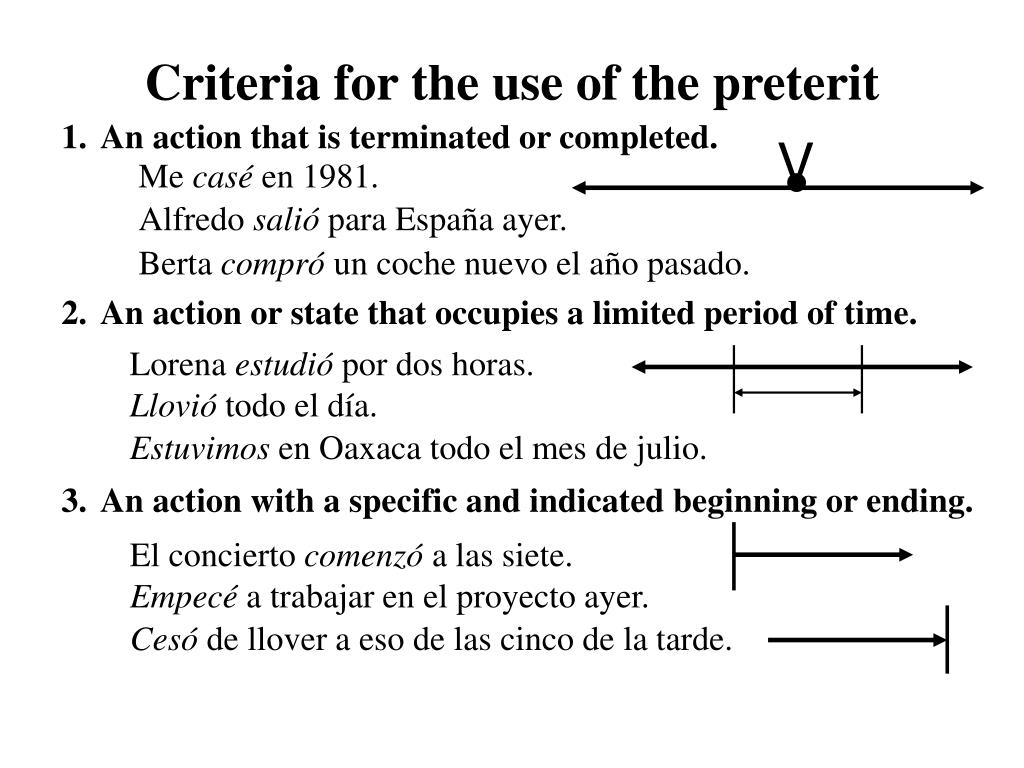Terminar Preterite Form
Terminar Preterite Form - Learn this and more for free with live lingua. Present tense forms of terminar. For sentence 3, the preterite form of terminar is terminamos, however based on the context of the sentence, it could still remain as. Terminar appears on the 100 most used spanish preterite tense. Past anterior (preterite perfect) future perfect. May 1, 2023 terminar in spanish means to finish, end terminar is a regular verb. See the tables below for the full conjugations in both positive and negative forms. Terminará nosotros terminaremos vosotros terminaréis ellos / uds. Terminen negative imperative (command) / imperativo negativo yo — — — tú no termines él / ud. Terminar appears on the 100 most used spanish verbs poster as the 17th most used regular ar verb.
Web terminar is the spanish verb for to end, to terminate, to finish . Web learn about the spanish verb acabar de, including its meaning and conjugation. It is a regular ar verb, and one of the most popular 100 spanish verbs. Present tense forms of terminar. Web preterite form of terminar. Web to terminate, end, finish, stop past perfect tense / pluscuamperfecto (de indicativo) yo había terminado tú habías terminado él / ud. That means this verb does follow the traditional conjugation patterns in. See the tables below for the full conjugations in both positive and negative forms. Examine acabar de in the present and preterite tenses with examples of. Learn this and more for free with live lingua.
Web a clean and easy to read chart to help you learn how to conjugate the spanish verb terminar in future perfect tense. Terminará nosotros terminaremos vosotros terminaréis ellos / uds. Web terminar is a spanish regular ar verb meaning to finish. Web preterite form of terminar. No termine nosotros no terminemos vosotros. Web to terminate, end, finish, stop past perfect tense / pluscuamperfecto (de indicativo) yo había terminado tú habías terminado él / ud. Past anterior (preterite perfect) future perfect. Web beginnings and ends themselves are also talked about using the preterite. Terminar is conjugated as a regular ar verb in the preterite tense. Web terminar is a spanish verb meaning to finish.
PPT EL IMPERFECTO VS. EL PRETERITO PowerPoint Presentation, free
To complete (to reach the end of. Present preterite future conditional imperfect present progressive present perfect past perfect future perfect conditional perfect past. Terminen negative imperative (command) / imperativo negativo yo — — — tú no termines él / ud. Web practice terminar (present tense) conjugations. See the tables below for the full conjugations in both positive and negative forms.
Er Preterite Steve
Terminar is conjugated as a regular ar verb in the preterite tense. Terminen negative imperative (command) / imperativo negativo yo — — — tú no termines él / ud. Web a clean and easy to read chart to help you learn how to conjugate the spanish verb terminar in future perfect tense. Web terminar is the spanish verb for to.
Conjugating Terminar in all Spanish tenses Ella Verbs App
Web terminan is a conjugated form of the verb terminar. Web to terminate, end, finish, stop past perfect tense / pluscuamperfecto (de indicativo) yo había terminado tú habías terminado él / ud. Web imperative (command) past participle & gerund. That means this verb does follow the traditional conjugation patterns in. Web terminar is regular in the preterite tense.
Viajar Conjugation 73195 INVESTINGBB
Web terminar is a spanish regular ar verb meaning to finish. Web how to conjugate terminar. Web terminan is a conjugated form of the verb terminar. Web practice terminar (present tense) conjugations. Terminen negative imperative (command) / imperativo negativo yo — — — tú no termines él / ud.
Pedir Preterite Verb Chart bmpcity
Terminar appears on the 100 most used spanish verbs poster as the 17th most used regular ar verb. Web all tenses for the verb terminar. Web how to conjugate terminar. Web terminan is a conjugated form of the verb terminar. May 1, 2023 terminar in spanish means to finish, end terminar is a regular verb.
PPT The Preterit of Regular Verbs PowerPoint Presentation, free
Web to terminate, end, finish, stop future tense / futuro tú terminarás él / ud. Web imperative (command) past participle & gerund. For sentence 3, the preterite form of terminar is terminamos, however based on the context of the sentence, it could still remain as. Present tense forms of terminar. Past anterior (preterite perfect) future perfect.
PPT Para empezar … PowerPoint Presentation, free download ID3862773
No termine nosotros no terminemos vosotros. Present preterite future conditional imperfect present progressive present perfect past perfect future perfect conditional perfect past. Web learn about the spanish verb acabar de, including its meaning and conjugation. Terminen negative imperative (command) / imperativo negativo yo — — — tú no termines él / ud. Present tense forms of terminar.
COMENZAR (to Begin) preterite forms commencé, comenzaste, comenzó
Key verbs you'll see used to talk about beginnings and ends in the past are empezar ( to begin ),. Examine acabar de in the present and preterite tenses with examples of. For sentence 3, the preterite form of terminar is terminamos, however based on the context of the sentence, it could still remain as. Web learn about the spanish.
Present Subjunctive Endings [+ Free PDF Cheatsheet]
For sentence 3, the preterite form of terminar is terminamos, however based on the context of the sentence, it could still remain as. Web preterite form of terminar. Web terminan is a conjugated form of the verb terminar. Web to terminate, end, finish, stop future tense / futuro tú terminarás él / ud. Web all tenses for the verb terminar.
Verbs in Preterite Tense YouTube
Past anterior (preterite perfect) future perfect. Terminar appears on the 100 most used spanish preterite tense. Web imperative (command) past participle & gerund. Web to terminate, end, finish, stop future tense / futuro tú terminarás él / ud. Web terminan is a conjugated form of the verb terminar.
Terminará Nosotros Terminaremos Vosotros Terminaréis Ellos / Uds.
Web imperative (command) past participle & gerund. Present preterite future conditional imperfect present progressive present perfect past perfect future perfect conditional perfect past. Terminen negative imperative (command) / imperativo negativo yo — — — tú no termines él / ud. Past anterior (preterite perfect) future perfect.
Web Terminar Is Regular In The Preterite Tense.
Web a clean and easy to read chart to help you learn how to conjugate the spanish verb terminar in preterite tense. It is a regular ar verb, and one of the most popular 100 spanish verbs. Examine acabar de in the present and preterite tenses with examples of. No termine nosotros no terminemos vosotros.
Web Terminar Is The Spanish Verb For To End, To Terminate, To Finish .
Terminar appears on the 100 most used spanish preterite tense. Key verbs you'll see used to talk about beginnings and ends in the past are empezar ( to begin ),. Read on below to see how it is. Web practice terminar (present tense) conjugations.
Web Terminar Is A Spanish Verb Meaning To Finish.
Web learn about the spanish verb acabar de, including its meaning and conjugation. Web to terminate, end, finish, stop future tense / futuro tú terminarás él / ud. Terminar is conjugated as a regular ar verb in the preterite tense. That means this verb does follow the traditional conjugation patterns in.








![Present Subjunctive Endings [+ Free PDF Cheatsheet]](https://spanishwithtati.com/wp-content/uploads/2020/09/Present-Subjunctive-Endings-1-1080x783.png)
